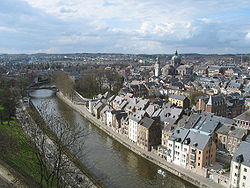Sambre
| Sambre | |
|---|---|
 The Sambre in the centre of Namur | |
 | |
| Location | |
| Countries | BelgiumandFrance |
| Physical characteristics | |
| Source | |
| • location | Picardy |
| • elevation | 199 m (653 ft) |
| Mouth | |
• location | MeuseatNamur |
• coordinates | 50°27′43″N4°52′15″E/ 50.46194°N 4.87083°E |
| Length | 193 km (120 mi) |
| Basin size | 2,740 square kilometres (1,060 sq mi) |
| Basin features | |
| Progression | Meuse→North Sea |
TheSambre(French:[sɑ̃bʁ]) is ariverin northernFranceand inWallonia,Belgium.It is a left-bank tributary of theMeuse,which it joins in the Wallonian capitalNamur.
The source of the Sambre is nearLe Nouvion-en-Thiérache,in theAisnedépartement.It passes through the Franco-Belgian coal basin, formerly an important industrial district. The navigable course begins in Landrecies at the junction with the Canal de la Sambre à l'Oise, which links with the central French waterway network (or did, until navigation was interrupted in 2006 following structural failures).[1]It runs 54 km and 9 locks 38.50m long and 5.20m wide down to the Belgian border at Jeumont. From the border the river is canalised in two distinct sections over a distance of 88 km with 17 locks. The Haute-Sambre is 39 km long and includes 10 locks of the same dimensions as in France, down to the industrial town ofCharleroi.The rest of the Belgian Sambre was upgraded to European Class IV dimensions (1350-tonne barges) in the immediate post-World War II period. It lies at the western end of thesillon industriel,which is stillWallonia's industrial backbone, despite the cessation of all the coal-mining and a decline in the steel industry. The river flows into theMeuseatNamur,Belgium.
The navigable waterway is managed in France by Voies Navigables de France and in Belgium by the Service Public Wallon -Direction générale opérationnelle de la Mobilité et des Voies hydrauliques(Operational Directorate of Mobility and Inland Waterways)[2]
Course
[edit]The Sambre flows through the followingdépartements of France,provinces of Belgiumand towns:
- Aisne(F):Barzy-en-Thiérache
- Nord(F):Landrecies,Aulnoye-Aymeries,Hautmont,Maubeuge
- Hainaut(B):Thuin,Montigny-le-Tilleul,Charleroi
- Namur(B):Floreffe,Namur
-
The Sambre atAulne Abbeyin Belgium
-
The Sambre at Flawinne (Namur)
-
The Sambre at Ham-sur-Sambre
-
The Sambre at Moustier-sur-Sambre
-
A barge on the Sambre inNamur
-
The Sambre inNamur
-
The canalised Sambre running through the centre ofCharleroi
Main tributaries
[edit]- Helpe Mineure[3]
- Helpe Majeure[3]
- Eau d’Heure[4](Eau d'Heure lakes)
- Hantes[3][4]
- Thure[3][4]
- Biesmelle[4]
- Thyria[4]
- Eau d’Yves[4]
- Piéton,northern tributary, confluence inCharleroi.[4][5]
- Hanzinne,[4]confluence inChâtelet
- Biesmes d’Aiseau[4]
- Orneau[4]
- Ligne[4]
- Eau d’Eppe[4]
- Ruisseau de Fosses[4]
- Solre[3]
Events
[edit]- On 24 February 1912, Regina Magritte, the mother of the famoussurrealistpainterRéné Magritte,drowned herself in this river atChâtelet.[6]
Battles
[edit]The 19th-century theory that the Sambre was the location ofJulius Caesar's battle against aBelgicconfederation(57 BC), was discarded a long time ago,[7]but is still repeated.
Three important battles were fought inFleurus,a suburb of Charleroi on the north bank of the Sambre: theThirty Years' WarBattle of Fleurus (1622),theNine Years' WarBattle of Fleurus (1690),and the crucial 26 June 1794Battle of Fleurus (1794),the most significant battle of theFlanders Campaignin theLow Countriesduring theFrench Revolutionary Wars.The last was fought on both banks of the river, culminating a campaign that had involved multiple crossings and re-crossings of the river.
Heavy fighting occurred along the river duringWorld War I,especially at the siege of Namur in 1914 (Battle of Charleroi) and in the last month of the warBattle of the Sambre (1918).
References
[edit]- ^Edwards-May, David (2010).Inland Waterways of France.St Ives, Cambs., UK: Imray. pp. 246–249.ISBN978-1-846230-14-1.
- ^Edwards-May, David (2014).European Waterways Map and Concise Directory.Lambersart, France: Transmanche. pp. 11–12, 17–20 and fold-out map.ISBN979-10-94429-00-6.
- ^abcdeSandre."Fiche cours d'eau - La Sambre Canalisée (D0--022-)".,see tab "Affluents"
- ^abcdefghijklm"Contrats de rivière en Wallonie - Sambre".Environnement.wallonie.be.Retrieved25 March2018.
- ^"Le Ruisseau" le Piéton "- Piéton, Village du Hainaut".Pieton.eu.Retrieved25 March2018.
- ^Harris, James C. (2007-08-01)."The Murderer Threatened (L'assassin Menacé)".Archives of General Psychiatry.64(8): 882–883.doi:10.1001/archpsyc.64.8.882.ISSN0003-990X.PMID17679631.
- ^Pierre Turquin ( "La Bataille de la Selle (du Sabis) en l' An 57 avant J.-C." in Les Études Classiques 23/2 (1955), 113-156) has proved beyond reasonable doubt that the battle was fought at theRiver Selle,west of modernSaulzoir.
External links
[edit]- River Sambre and Canal de la Sambre à l'Oisewith maps and details of places, moorings and facilities for boats, by the author ofInland Waterways of France,Imray
- Navigation details for 80 French rivers and canals(French waterways website section)







